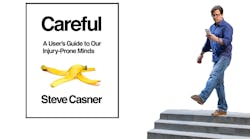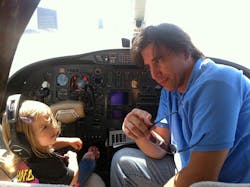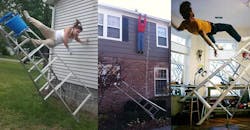As a research psychologist for NASA, Steve Casner spent decades analyzing how pilots think and helping turn those findings into safety protocols for the aviation industry. A few years ago he found a new calling: making the whole world safer.
Collecting decades of personal anecdotes and global tragedies, loads of safety data and even more common sense, Casner has authored Careful: A User’s Guide to Our Injury-Prone Minds (available May 23).
This insightful, easy read is his attempt to show that despite our technology and greater emphasis on safety at work, we face just as many perils to our mortality and good health as our parents and grandparents, who never wore seatbelts and chain-smoked while filling up at the pump. For example, he mentions 4,005 people were killed at work in 2014, while 47,732 people headed to the emergency room following a TV set-related incident.
We recently asked Casner, a trained pilot and overall adrenaline seeker, how to re-calibrate our brains, so that a flawless safety record is the one thing from work we wouldn’t mind bringing home.
NED: What made you decide to write this book?
I've been working in the aviation industry for almost 30 years and we've got aviation safety to the point where the odds of something bad happening to you on that airplane are infinitesimal. It is unbelievably safe. It’s so safe that I think we may have helped to get rid of our own jobs, actually.
So I started looking outside of the cockpit and I realized there are bigger problems out there. I got really interested in automobile safety. We’re now seeing an unprecedented rise in car crashes. How can this be happening? It got safer every year and now all of a sudden it's leaping upward again. And then I started looking at increases in ladder injuries. It's like all of a sudden, the safety gains we've enjoyed for a hundred years just reversed and started going up again. What's going on?
We didn't turn into a bunch of klutzes or dum dums. So what could possibly explain this? That question is what really captured my interest. Then I realized it was probably time to upgrade the way we all think about being careful.
NED: The workplace seems safer than ever, with a huge emphasis on protecting workers. So how are we still injury-prone?
We're not doing a good enough job of bringing workplace safety home. It's the same people in the USA that have a 2.9% fatality rate at work yet who have a 50% fatality rate at home. Just look at the words we use being at work and being at home: “I'm on (work), I’m off work.”
We may be off a lot of things; maybe we’re off our safety game.
NED: Why do you think that is?
In the workplace we have a culture where we can make people go through safety training. We can infuse the safety mindset throughout the whole work environment. And then of course we do our job in the presence of other people. If I’m at home slicing a bagel, I’m the only one there. There aren’t ten other bagel slicers watching what I’m doing and there’s no signage and I don’t have to get checked out on any equipment.
People under-recognize how much support they get in the workplace.
NED: You write a lot about how not paying attention leads to accidents. What do you think when you see events like the recent texting and driving tragedy in Texas where a pickup driver killed 13?
Psychologists know that there's no such thing as multitasking. We have to switch back and forth between tasks and, while we’re looking at one, we’re missing the other. Our ability to pay attention is much more limited than we think. Things can be happening behind us, on the side, above us, and we will never see any of these things if we're not really looking at them and thinking about them. I think we need to get to the point where we realize that we’re not super heroes. I’ve got to pay attention to something important and I need to save the other stuff for later.
This is really a central point of the book. For so long we have relied on simple safety features and advice that really seemed obvious, like “Don't run with scissors.” What's happening now is we're collecting equipment gadgets and activities for which dangers are not at all apparent. When I look down at a pair of scissors, it just looks a little dangerous. That’s not true for dividing our attention between a road and a smartphone. It doesn’t seem that dangerous but it really is.
So we have a big rise in pedestrian crashes because they’re on their phones or the drivers are on their phones or maybe both.
NED: You lead the book with the example of riding in your grandpa’s pickup flatbed and not thinking how dangerous that was. Have we changed much since then?
We like to talk about the good old days but safety was worse than it is now, even though it was a simpler world. My grandfather didn't have to decide whether he was going to watch a movie while driving a car. He couldn’t put a film projector and screen in his pickup truck. There was no danger there because that was not even part of his world. And now it's a part of everyone's world. It's so tempting to say “Ok, I can just look at the movie on my phone and then look at the road.” It’s a world that’s more tempting and loaded with consequences than ever before.
And as drunk driving goes down, we’ve now got drugged driving on the increase, as well as distracted driving and even fatigued, or drowsy, driving.
Now that you have a daughter, has your outlook on safety changed?
Kids might be our best hope for the future of safety. Teaching grownups to be more safe is like pulling teeth; they already think they know everything. But kids are malleable. They can learn. Who makes sure trash goes in the recycling? Kids. Who can figure out how a new phone works in ten seconds after a grownup stares at it for ten minutes in total confusion? Kids. And the best thing of all, we can train them to nag and yell at us when we do dangerous things like use our phones while driving, or stand on chairs, or use a ladder or a tool in a way that it shouldn’t be. Kids just might be the only hope humankind has. So above all, I’m teaching my kid to be safe and to shame me when I’m not.
NED: How else are our minds injury-prone?
There are so many traps in our everything thinking about being safe. When we’re in a car there’s this belief that making a red light is somehow going to save us time. Study after study shows that whatever you gain here is just going to be frittered away somewhere else. And how many times do you watch someone hurry through an intersection and doesn’t move when the next light turns green because they're on their phone.
We all make occasional errors but we’re not that good at admitting it and preparing for them in advance. We tend to dismiss advice. Even really good advice. We get risk all wrong. We worry in the back of airplanes that wouldn’t crash if we rode on them ten million times. Yet we’ll stare down at a phone while we’re in a crosswalk as if the drivers coming at us don’t have phones of their own.
We need to seriously overhaul the way we think about being careful, and that’s really the whole point of the book.
NED: Do you think autonomous cars will fix some of this?
I’ve been involved with developing semi-autonomous cars and initially the plan was to automate more and more until we had fully autonomous cars. I’ve argued that that approach may not work.
Humans don't respond well to being partially involved in a job like driving a car. I think if we have a somewhat capable autopilot operate a vehicle, we're just going to end up being even more distracted than before. Then if something goes wrong the autopilot is going to scream at us and we’ll have to jump in at the last second. I think we’re going to have to take an all-or-nothing approach or it’s not going to work.
NED: What’s something that shocked you while researching the book?
One researcher studying texting and driving among college kids gave them surveys and at the bottom of the survey asked them to “Name anything else you do in a car while driving.” She found an astonishing number of college kids indicated that they were engaging in some form of sexual behavior while driving the car. I didn't see that one coming at all.
NED: What should plant and safety managers take away after reading this book?
First, they should take a victory lap to celebrate how unbelievably far they’ve come with industrial safety. Next, they should realize that we can do even better. Compare yourself to aviation. Safetywise, they’re kicking everybody’s ass. View it as a competition. Just get anywhere close to the safety record of a major airline.
NED: How do you take this home with you? How do you maintain the same amazing safety record after you leave work?
That won’t be easy. We need to build it into the culture just like we did at work and just like we did with things like littering and recycling outside of work. We need to get to a place where people think that texting en route or standing on a swivel chair with a screwdriver between your teeth just isn’t cool anymore.
Companies have plenty of incentives to help with this. Companies pay a price when people leave the workplace and get hurt, even if they’re off. If I hurt myself on Sunday, I’m probably not coming into work on Monday.














